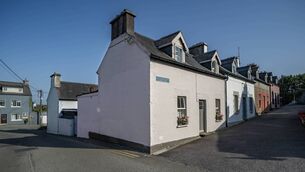Living in glass houses
Recent legislation places extra responsibilities on the owners of what are usually described as listed buildings. Their owners by and large accept the restrictions gladly where they make sense especially as there is some help available to meet the costs of maintenance.
Although cut-backs in the country-wide application of the national Conservation Grants Scheme are officially justified on the grounds that the total allocation was not taken up for the year 1999-2000, the very existence of the scheme takes some of the terror out of the responsibilities which are now part and parcel of owning a property worthy of preserving. Or at least of such a property where the local authority has decided that it is worth preserving. In other words, defining it as a Protected Structure
Apart from the financial help available, there is also advice and there are also guide-books. The Conservation officer in the first place will explain about grants (the usual amount is 50% of the approved costs, with a maximum grant of 13,000 euro). The most recent legislation means that the listing covers all parts of the building inside and out, so even changing the bathroom taps or inserting new light fittings or re-hanging a door on an out-house or re-roofing a greenhouse means a call to the Planning Office to find out what works are exempt. This officer can also advise on the best workers and the preferred methods to employ, and while Cork's Conservation officer Pat Ruane says that the real value of the scheme is that even relatively small grants have a huge effect by unlocking money which might otherwise not be spent at all, it is also an important fact that by working with accredited experts in conservation and preserving the appearance and solidity of your building inside and out you are adding greatly to its value.
So there is no need to despair if you find that home is a heritage site or the place of business an architectural treasure. The conservation grants are designed to help bridge the gap between the cost of the quick-fix and that of the more painstaking slate-by-slate reconstruction. This assistance is critical when it comes replacement windows which have ruined more individual houses and entire streets than can be counted. The repair and refurbishment of timber sash windows form one of the main items on the conservation grants agenda. Others include the repointing of brickwork, the reslating and leading of roofs, the repair and recarving of door surrounds and of interior plaster-work, the preservation of exterior stone-work and carving or of domestic stained glass (a feature in which Cork rejoices, as revealed in the doorways of parts of Blackrock, Sundays Well and Donovan's Road.)
There are regulatory penalties for wrong-doing: not only can a local authority insist that repairs be carried out or even slap a compulsory purchase order on a neglected building, it can also fine or imprison owners who ignore their obligations. Fines of up to 1.25 million euro and 12,700 euro for each day of a continuing offence, and prison for up to 5 years, are no deterrant if not likely to be applied, but variations on that financial theme could be effective. Where the scheme falls apart is where the authorities themselves ignore abuses or else apply the rules so stringently that they actually deter maintenance and upkeep. It is dismaying, for example, when people who have meticulously observed the regulations see others ignoring them without any censure; it is also extremely problematical for a proprietor whose house is surrounded by valuable land which might be sold so that the proceeds could finance restoration of the house. But developers insist on having planning permission before completing a sale and such permission can be affected or even refused because of the proximity of a listed building. Often the fate of the building depends on the successful sale of the land; decaying houses fester throughout the Irish countryside like a skin rash because of a simple lack of imagination.
This is a national disease. There is no scheme in Ireland similar, for example, to the National Trust in Britain, by which historically or architecturally valuable properties, - buildings and land and in some cases entire landscapes can be endowed and gifted to a designated organisation. Ideally it should be possible for local authorities to buy the land around a listed building so as to protect the immediate environment and setting of the house while freeing other acres for development which in turn would fund the independent maintenance of the buildings, gardens and visual heritage. In Cork the entire northern ridge from the Lee Road to Glanmire should be managed in such a way, given that these wooded heights are visually characteristic of the city's suburban growth, provide a unique backdrop to the city centre itself and support both houses and parkland typical of Cork's merchant and sea-faring history along with all the associated flora and fauna found nowhere else this close to a city.
The failure of architectural sensitivity, the lack of aesthetic values in development models and the refusal or inability of local authorities to monitor existing legislation and apply imaginative zoning principles continue to add to Ireland's shocking list of conservation disasters, typified by places ranging from Cobh to Carton. That's the country-wide result of carelessness or ruthlessness, but it's also the kind of thing which makes many householders feel that designation as a protected structure is a tragedy rather than a tribute. In fact there is no reason for panic; instead a whole new kind of life is on offer, a new vocabulary, a new way of seeing things and a new way of doing things (which is often an old way of doing things!).
Although there is as yet no equivalent in Cork, the Dublin Civic Trust has produced a very useful book "Period Houses; A Conservation Guidance Manual" (Dublin Civic Trust, 4 Castle Street, Dublin 2; 01 475 6911) which covers everything from fire safety to rising damp, from the right way to clean brick facades to the rebuilding of chimney stacks. Interior Georgian plaster work may not be your problem, but putty, glazing bars and cracked rendering are common enough complaints even where a house does not have the distinction, and the market value, of being a Protected Structure.
Conservation Officer, Cork City Council, Navigation House (021 492 4086)
www.corkcity.ie or Conservation Officer, Cork County Council, Inishmore, Ballincollig, Co. Cork, 021 4878170 www.corkcoco.ie













